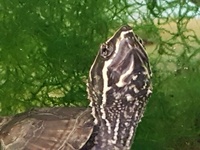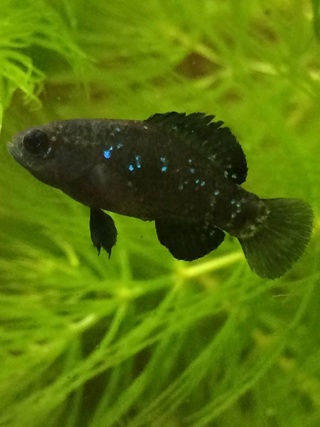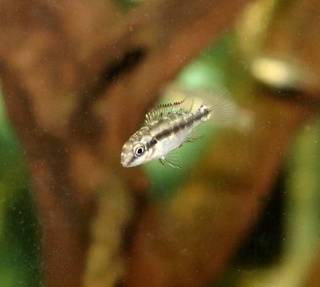fish medicine in Canada...
3 posters
:: Freshwater :: Freshwater General
Page 1 of 1
 fish medicine in Canada...
fish medicine in Canada...
I feel as though I am the last guy who should be posting on this topic. I am a follower of two schools of thought regarding fish/aquarium health: First, that long and careful quarantine of all new additions, both plants and fish, is essential to keep the nasties out of your fishtank in the first place. And second, that almost anything can be cured in an otherwise-healthy fish by extreme attention to water quality, normally achieved by frequent, regular and massive water changes.
I have used virtually no medications on my fish, although I admit to keeping some formalin on hand as I will fall back on that (combined with increased temps) in some instances of Ich. I'm also a fan of filters using diatomaceous earth, which will remove most parasites from the water column when they are in their free-swimming stage.
Now...having said that, I was a bit dismayed recently when one of my tanks displayed clear and unmistakable signs of an infestation of Camallanus worms. I couldn't figure out where they had come from...but a bright red worm dangling and squirming from a fish's nether porthole is pretty tough to ignore or explain away. But...what to do? The fish medication aisle in a Canadian petstore is a thing of the past. The powers-that-be took the long-overdue step of banning the sale of over-the-counter antibiotics for fish use (a move which I heartily applaud) but in typical Canadian fashion the knee-jerk reaction was carried too far, to the point where essentially any medication is no longer available. The days of beginner aquarists dosing with a cocktail of 8 or 10 mysterious miracle cures are long gone.
A little bit of snooping around on the 'net revealed that puppy de-wormers are still available, and I found one on the shelf at PetSmart called ProSense. It's a syrupy brownish liquid that looks (and even smells...) a bit like Kahlua. The active ingredient is not levamisole or flubendazole (the "preferred" treatments) but rather piperazine, which is touted as being effective against roundworms (the group into which Camallanus falls). Dosages are given on the box, but it's very difficult to extrapolate them to animals as tiny as aquarium fish, especially when taken orally as this medication must be. I simply dripped a few drops into a glass and then added a broken-up chunk of freeze-dried Tubifex worms and let it soak in. I'm sure brine shrimp or black worms would work as well; anything freeze-dried soaks up liquid like a sponge. Ten minutes later I offered it to my fish, who attacked with gusto as they always do.
I repeated this at weekly intervals two more times, and did extensive vacuuming of the bottom at least every other day. Examining the gunk after it settled out in a bucket I was able to spot numerous motionless red Camallanus adults. Apparently the medication works to paralyze them, allowing them to be passed by the fish. The larvae inside these adults are supposedly unaffected, so the repeat treatments were aimed at nuking them after they re-infect the fish. Changing lots of water and vacuuming up debris must help remove them as well.
It's too soon to say for sure, but results look promising. The only fish I have lost throughout this procedure was a single large female Ameca, who was the first one showing symptoms. By the time I got my act together and began treatment, she had progressed to the point of no longer eating, so had no chance. Several other fish with "danglers" seem fully recovered.
So, no promises, no guarantees...but Camallanus tends to kill fish, so if you can't find or obtain the "proper" stuff, you have nothing to lose by trying this course of action. It's an inexpensive and easily-available alternative treatment worth trying. These critters are only able to go through a couple of generations of their standard life cycle, since they normally need an intermediate Copepod host in the wild. So, hitting them quickly and "with extreme prejudice" should get a tank back to a worm-free state with minimal loss of fish.
Word of advice: if you follow my methodology, you may be tempted...as I was...to keep some of the paralyzed adult worms in a container for awhile to see if they recover from the treatment. If you do so...do NOT answer your wife's inevitable question as to the origin of the worms at which you are suspiciously peering. Telling the truth at that point...i.e. "They were pooped out by my fish"...will put things into a downward spiral pretty quickly.
I have used virtually no medications on my fish, although I admit to keeping some formalin on hand as I will fall back on that (combined with increased temps) in some instances of Ich. I'm also a fan of filters using diatomaceous earth, which will remove most parasites from the water column when they are in their free-swimming stage.
Now...having said that, I was a bit dismayed recently when one of my tanks displayed clear and unmistakable signs of an infestation of Camallanus worms. I couldn't figure out where they had come from...but a bright red worm dangling and squirming from a fish's nether porthole is pretty tough to ignore or explain away. But...what to do? The fish medication aisle in a Canadian petstore is a thing of the past. The powers-that-be took the long-overdue step of banning the sale of over-the-counter antibiotics for fish use (a move which I heartily applaud) but in typical Canadian fashion the knee-jerk reaction was carried too far, to the point where essentially any medication is no longer available. The days of beginner aquarists dosing with a cocktail of 8 or 10 mysterious miracle cures are long gone.
A little bit of snooping around on the 'net revealed that puppy de-wormers are still available, and I found one on the shelf at PetSmart called ProSense. It's a syrupy brownish liquid that looks (and even smells...) a bit like Kahlua. The active ingredient is not levamisole or flubendazole (the "preferred" treatments) but rather piperazine, which is touted as being effective against roundworms (the group into which Camallanus falls). Dosages are given on the box, but it's very difficult to extrapolate them to animals as tiny as aquarium fish, especially when taken orally as this medication must be. I simply dripped a few drops into a glass and then added a broken-up chunk of freeze-dried Tubifex worms and let it soak in. I'm sure brine shrimp or black worms would work as well; anything freeze-dried soaks up liquid like a sponge. Ten minutes later I offered it to my fish, who attacked with gusto as they always do.
I repeated this at weekly intervals two more times, and did extensive vacuuming of the bottom at least every other day. Examining the gunk after it settled out in a bucket I was able to spot numerous motionless red Camallanus adults. Apparently the medication works to paralyze them, allowing them to be passed by the fish. The larvae inside these adults are supposedly unaffected, so the repeat treatments were aimed at nuking them after they re-infect the fish. Changing lots of water and vacuuming up debris must help remove them as well.
It's too soon to say for sure, but results look promising. The only fish I have lost throughout this procedure was a single large female Ameca, who was the first one showing symptoms. By the time I got my act together and began treatment, she had progressed to the point of no longer eating, so had no chance. Several other fish with "danglers" seem fully recovered.
So, no promises, no guarantees...but Camallanus tends to kill fish, so if you can't find or obtain the "proper" stuff, you have nothing to lose by trying this course of action. It's an inexpensive and easily-available alternative treatment worth trying. These critters are only able to go through a couple of generations of their standard life cycle, since they normally need an intermediate Copepod host in the wild. So, hitting them quickly and "with extreme prejudice" should get a tank back to a worm-free state with minimal loss of fish.
Word of advice: if you follow my methodology, you may be tempted...as I was...to keep some of the paralyzed adult worms in a container for awhile to see if they recover from the treatment. If you do so...do NOT answer your wife's inevitable question as to the origin of the worms at which you are suspiciously peering. Telling the truth at that point...i.e. "They were pooped out by my fish"...will put things into a downward spiral pretty quickly.

jjohnwm- Angel Fish

- Posts : 158
Join date : 2015-09-08
Location : Interlake region of Manitoba
 Re: fish medicine in Canada...
Re: fish medicine in Canada...
I agree John keeping the wife in the dark as to origins of such worms etc. might be in your best interest. and good to know about the alternative worm medicine.

Fores41- Pleco Poster

- Posts : 829
Join date : 2013-09-17
Location : Williams Lake,BC
 Re: fish medicine in Canada...
Re: fish medicine in Canada...
Just a quick follow-up to this posting: It's been about 6 weeks since the final treatment with the puppy wormer and there have been no signs of the worm infestation. No other adult fish have been lost, and several litters of both Ameca and Skiffia have been born in the interim and appear healthy. I'm going to cautiously call ProSense puppy de-wormer a successful and safe treatment for Camallanus. Use at your own risk, of course, but at least be aware that the option exists.

jjohnwm- Angel Fish

- Posts : 158
Join date : 2015-09-08
Location : Interlake region of Manitoba

alexmtl- Veteran Member

- Posts : 3274
Join date : 2013-09-07
Location : Montreal Quebec
 Similar topics
Similar topics» Importing fish from USA to Canada
» smart fish, dumb fish, pink fish...um, what rhymes with dumb?
» For those of you who like big fish....
» Anywhere that sells aquarium frames in Canada?
» More New Fish!!!!!!
» smart fish, dumb fish, pink fish...um, what rhymes with dumb?
» For those of you who like big fish....
» Anywhere that sells aquarium frames in Canada?
» More New Fish!!!!!!
:: Freshwater :: Freshwater General
Page 1 of 1
Permissions in this forum:
You cannot reply to topics in this forum
 Alexmtl
Alexmtl


» Anyone still around? Need help transporting fish
» Stocking suggestions
» New Tank Purchase
» 3 Gallon Tetra half moon tank
» White floaty stuff in gold fish tank
» Ammonia in tap water
» Need advice for beginner with fresh water tank
» Fluval FX5 hose size?
» smart fish, dumb fish, pink fish...um, what rhymes with dumb?
» Is K&E sandblasting sand same as Black diamond?
» What the...is that a leak? NOOOOOOOOOOO!!!!! (a comedy of horrors...)
» Air stones and the noise they make
» aquatic medications
» film like stuff on the water surface of shark tank
» Articles on swordtail behaviour and fathead minnows
» Lets see your predators!
» Humane way to PTS a shark
» My tanks (Introducing myself)
» Build your own aquarium